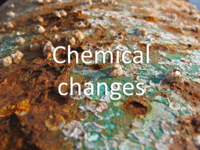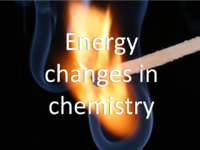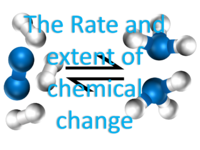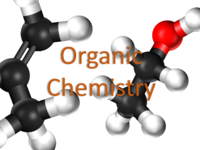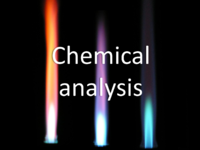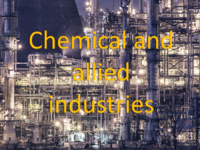Difference between revisions of "Chemistry Key Stage 4"
(→The comparison of yield and atom economy of chemical reactions) |
|||
| (31 intermediate revisions by the same user not shown) | |||
| Line 1: | Line 1: | ||
| + | [[Main Page]] - [[Science Subject]] - [[Science Key Stage 4]] - [[Chemistry Key Stage 4]] | ||
| + | |||
| + | {| border="1" style="border-collapse:collapse" | ||
| + | | style="height:20px; width:300px; text-align:center;" |[[GCSE Chemistry Exam Papers]] | ||
| + | | style="height:20px; width:300px; text-align:center;" |[[GCSE Chemistry Required Practicals]] | ||
| + | |||
| + | |} | ||
| + | |||
| + | {| border="1" style="border-collapse:collapse" | ||
| + | |- | ||
| + | |[[File:AtomicStructureandthePeriodicTableLogo.png|center|200px|link=KS4 Chemistry Atomic Structure and the Periodic Table]] | ||
| + | |[[File:StructureBondingandthePropertiesofMatterLogo.png|center|200px|link=KS4 Chemistry Structure Bonding and the Properties of Matter]] | ||
| + | |[[File:ChemicalChangesLogo.png|center|200px|link=KS4 Chemistry Chemical Changes]] | ||
| + | |- | ||
| + | |[[File:EnergyChangesinChemistryLogo.png|center|200px|link=KS4 Chemical Energy Changes in Chemistry]] | ||
| + | |[[File:TheRateandExtentofChemicalChangeLogo.png|center|200px|link=KS4 Chemistry The Rate and Extent of Chemical Change]] | ||
| + | |[[File:OrganicChemistryLogo.png|center|200px|link=KS4 Chemistry Organic Chemistry]] | ||
| + | |- | ||
| + | |[[File:ChemicalAnalysisLogo.png|center|200px|link=KS4 Chemistry Chemical Analysis]] | ||
| + | |[[File:ChemicalandAlliedIndustriesLogo.png|centre|200px|link=KS4 Chemistry Chemical and Allied Industries]] | ||
| + | |[[File:EarthandAtmosphericScienceLogo.png|center|200px|link=KS4 Chemistry Earth and Atmospheric Science]] | ||
| + | |} | ||
| + | |||
==Atomic Structure and the Periodic Table== | ==Atomic Structure and the Periodic Table== | ||
===[[Atom]]s=== | ===[[Atom]]s=== | ||
| Line 22: | Line 45: | ||
===[[Periodic Table]]=== | ===[[Periodic Table]]=== | ||
| + | ====The First 20 Elements==== | ||
| + | *[[Hydrogen]] | ||
| + | *[[Helium]] | ||
| + | *[[Lithium]] | ||
| + | *[[Beryllium]] | ||
| + | *[[Boron]] | ||
| + | *[[Carbon]] | ||
| + | *[[Nitrogen]] | ||
| + | *[[Oxygen]] | ||
| + | *[[Fluorine]] | ||
| + | *[[Neon]] | ||
| + | *[[Sodium]] | ||
| + | *[[Magnesium]] | ||
| + | *[[Aluminium]] | ||
| + | *[[Silicon]] | ||
| + | *[[Phosphorus]] | ||
| + | *[[Sulphur]] | ||
| + | *[[Chlorine]] | ||
| + | *[[Argon]] | ||
| + | *[[Potassium]] | ||
| + | *[[Calcium]] | ||
| + | |||
====[[Mendeleev's Periodic Table]]==== | ====[[Mendeleev's Periodic Table]]==== | ||
=====[[Group (Chemistry)|Groups]]===== | =====[[Group (Chemistry)|Groups]]===== | ||
| Line 95: | Line 140: | ||
**[[Double Bond]] | **[[Double Bond]] | ||
**[[Triple Bond]] | **[[Triple Bond]] | ||
| + | ====Common Compounds==== | ||
| + | =====Products of Neutralisations===== | ||
| + | *[[Water]] | ||
| + | *[[Carbon Dioxide]] | ||
| + | *[[Salt]]s | ||
| + | =====Metal Oxides===== | ||
| + | *[[Magnesium Oxide]] | ||
| + | *[[Iron Oxide]] | ||
| + | *[[Copper Oxide]] | ||
| + | =====Common Acids===== | ||
| + | *[[Hydrochloric Acid]] | ||
| + | *[[Nitric Acid]] | ||
| + | *[[Sulphuric Acid]] | ||
| + | =====Salts===== | ||
| + | *[[Halide]]s | ||
| + | *[[Nitrate]]s | ||
| + | *[[Sulphate]]s | ||
====[[Carbon]]==== | ====[[Carbon]]==== | ||
| Line 169: | Line 231: | ||
====[[Electrolysis#Electrolysis of Molten Ionic Compounds|Electrolysis of Molten Ionic Compounds]]==== | ====[[Electrolysis#Electrolysis of Molten Ionic Compounds|Electrolysis of Molten Ionic Compounds]]==== | ||
====[[Electrolysis#Electrolysis of Aqueous Ionic Compounds|Electrolysis of Aqueous Ionic Compounds]]==== | ====[[Electrolysis#Electrolysis of Aqueous Ionic Compounds|Electrolysis of Aqueous Ionic Compounds]]==== | ||
| + | [[GCSE Chemistry Required Practical: Electrolysis of a Solution]] | ||
===[[Redox Reaction]]s=== | ===[[Redox Reaction]]s=== | ||
| Line 181: | Line 244: | ||
**[[Activation Energy]] | **[[Activation Energy]] | ||
*[[Bond Energy]] | *[[Bond Energy]] | ||
| + | [[GCSE Chemistry Required Practical: Investigating Temperature Changes]] | ||
===Carbon Compounds as Fuels and Feedstock=== | ===Carbon Compounds as Fuels and Feedstock=== | ||
| Line 193: | Line 257: | ||
==The Rate and Extent of Chemical Change== | ==The Rate and Extent of Chemical Change== | ||
===Factors that influence the rate of reaction, including catalysts=== | ===Factors that influence the rate of reaction, including catalysts=== | ||
| − | *[[Rate of Reaction]] | + | *[[Rate of Reaction]] |
**[[Rate of Reaction#Determining the Rate of Reaction|Determining the Rate of Reaction]] | **[[Rate of Reaction#Determining the Rate of Reaction|Determining the Rate of Reaction]] | ||
**[[Rate of Reaction#Factors Affecting the Rate of Reaction|Factors Affecting the Rate of Reaction]] | **[[Rate of Reaction#Factors Affecting the Rate of Reaction|Factors Affecting the Rate of Reaction]] | ||
**[[Collision Theory]] | **[[Collision Theory]] | ||
**[[Catalyst]] | **[[Catalyst]] | ||
| + | [[GCSE Chemistry Required Practical: Concentration and Rate of Reaction]] | ||
===Reversible reactions and dynamic Equilibrium=== | ===Reversible reactions and dynamic Equilibrium=== | ||
| Line 208: | Line 273: | ||
====[[Organic Compound]]s==== | ====[[Organic Compound]]s==== | ||
*[[Alkane]]s | *[[Alkane]]s | ||
| + | **[[Methane]] | ||
| + | **[[Ethane]] | ||
| + | **[[Propane]] | ||
| + | **[[Butane]] | ||
*[[Alkene]]s | *[[Alkene]]s | ||
| + | **[[Ethene]] | ||
| + | **[[Propene]] | ||
| + | **[[Butene]] | ||
*[[Alcohol]]s | *[[Alcohol]]s | ||
| + | **[[Methanol]] | ||
| + | **[[Ethanol]] | ||
| + | **[[Propanol]] | ||
| + | **[[Butanol]] | ||
*[[Carboxylic Acid]]s | *[[Carboxylic Acid]]s | ||
| + | **[[Methanoic Acid]] | ||
| + | **[[Ethanoic Acid]] | ||
| + | **[[Propanoic Acid]] | ||
| + | **[[Butanoic Acid]] | ||
| + | |||
====[[Homologous Series]]==== | ====[[Homologous Series]]==== | ||
*[[Functional Group]] | *[[Functional Group]] | ||
| Line 224: | Line 305: | ||
*[[Alcohol#Reactions of Alcohols|Reactions of Alcohols]] | *[[Alcohol#Reactions of Alcohols|Reactions of Alcohols]] | ||
*[[Carboxylic Acid#Reactions of Carboxylic Acids|Reactions of Carboxylic Acids]] | *[[Carboxylic Acid#Reactions of Carboxylic Acids|Reactions of Carboxylic Acids]] | ||
| − | ===Synthetic and naturally | + | ===Synthetic and naturally occurring polymers including DNA=== |
*[[Polymer]] | *[[Polymer]] | ||
*[[Monomer]] | *[[Monomer]] | ||
| Line 242: | Line 323: | ||
*[[Pure]] | *[[Pure]] | ||
*[[Mixture]] | *[[Mixture]] | ||
| + | **[[Formulation]] | ||
====[[Separating Mixtures]]==== | ====[[Separating Mixtures]]==== | ||
| + | *[[Melting Point]] | ||
*[[Filtration]] | *[[Filtration]] | ||
*[[Evaporation of Solutions|Crystallisation]] | *[[Evaporation of Solutions|Crystallisation]] | ||
| + | [[GCSE Chemistry Required Practical: Making Salt]] | ||
*[[Distillation]] | *[[Distillation]] | ||
*[[Fractional Distillation]] | *[[Fractional Distillation]] | ||
| + | *[[Melting Point]] | ||
*[[Chromatography]] | *[[Chromatography]] | ||
**[[Stationary Phase]] | **[[Stationary Phase]] | ||
| Line 252: | Line 337: | ||
**[[Chromatogram]] | **[[Chromatogram]] | ||
**[[Retention Factor]]s | **[[Retention Factor]]s | ||
| − | + | [[GCSE Chemistry Required Practical: Calculating Retention Factors]] | |
===Conservation of mass and the quantitative interpretation of balanced equations=== | ===Conservation of mass and the quantitative interpretation of balanced equations=== | ||
| Line 261: | Line 346: | ||
*[[Relative Formula Mass]] | *[[Relative Formula Mass]] | ||
===Higher: Use of amount of substance in relation to masses of pure substances=== | ===Higher: Use of amount of substance in relation to masses of pure substances=== | ||
| − | *[[ | + | *[[Avogadro Constant]] |
*[[Mole]] | *[[Mole]] | ||
*[[Balanced Symbol Equation]] | *[[Balanced Symbol Equation]] | ||
| Line 273: | Line 358: | ||
===Principles for determining the concentrations of solutions=== | ===Principles for determining the concentrations of solutions=== | ||
| − | *[[Molarity]] | + | *[[Molarity]] |
| − | *[[Limiting Reactant]]s | + | *[[Limiting Reactant]]s |
| + | |||
===Identification of ions by chemical and spectroscopic means=== | ===Identification of ions by chemical and spectroscopic means=== | ||
*[[Testing for Aqueous Ions]] | *[[Testing for Aqueous Ions]] | ||
| Line 284: | Line 370: | ||
**[[Spectroscopy]] | **[[Spectroscopy]] | ||
*[[Instrumental Chemical Analysis]] | *[[Instrumental Chemical Analysis]] | ||
| + | [[GCSE Chemistry Required Practical: Identifying Unknown Compounds]] | ||
==Chemical and Allied Industries== | ==Chemical and Allied Industries== | ||
| Line 319: | Line 406: | ||
===Higher: The balance between equilibrium position and rate in industrial processes=== | ===Higher: The balance between equilibrium position and rate in industrial processes=== | ||
*[[Dynamic Equilibrium]] | *[[Dynamic Equilibrium]] | ||
| − | **[[Equilibrium Position]] | + | **[[Equilibrium Position (Chemistry)|Equilibrium Position]] |
===Agricultural productivity and the use of nitrogen, phosphorus and potassium-based fertilisers=== | ===Agricultural productivity and the use of nitrogen, phosphorus and potassium-based fertilisers=== | ||
*[[Haber Process]] | *[[Haber Process]] | ||
*[[NPK]] | *[[NPK]] | ||
| − | *[[Industrial Production of Fertilisers]] | + | *[[Industrial Production of Fertilisers]] |
===The comparison of yield and atom economy of chemical reactions=== | ===The comparison of yield and atom economy of chemical reactions=== | ||
| Line 332: | Line 419: | ||
==Earth and Atmospheric Science== | ==Earth and Atmospheric Science== | ||
| + | ===The composition and evolution of the Earth's atmosphere since its formation=== | ||
| + | *[[Earth's Atmosphere]] | ||
| + | |||
| + | ===Carbon Dioxide and Methane as greenhouse gases=== | ||
| + | *[[Greenhouse Effect]] | ||
| + | **[[Greenhouse Gas]]es | ||
| + | *[[Global Warming]] | ||
| + | **[[Anthropogenic Global Warming]] | ||
| + | *[[Climate Change]] | ||
| + | *[[Geoengineering]] | ||
| + | ===Common atmospheric pollutants and their sources=== | ||
| + | *[[Air Pollution]] | ||
| + | |||
| + | ===The Earth's water resources and obtaining potable water=== | ||
| + | *[[Potable Water]] | ||
| + | *[[Water Treatment]] | ||
| + | [[GCSE Chemistry Required Practical: Purifying Water]] | ||
Latest revision as of 22:21, 3 September 2020
Main Page - Science Subject - Science Key Stage 4 - Chemistry Key Stage 4
| GCSE Chemistry Exam Papers | GCSE Chemistry Required Practicals |
Contents
Atomic Structure and the Periodic Table
Atoms
Atomic Structure
- The Dalton Model of the Atom
- The Plum Pudding Model of the Atom
- The Nuclear Model of the Atom
- The Bohr Model of the Atom
- Nucleus
- Electrons
- Atomic Number
- Relative Atomic Mass
- Calculating the Numbers of Protons, Neutrons and Electrons
Periodic Table
The First 20 Elements
- Hydrogen
- Helium
- Lithium
- Beryllium
- Boron
- Carbon
- Nitrogen
- Oxygen
- Fluorine
- Neon
- Sodium
- Magnesium
- Aluminium
- Silicon
- Phosphorus
- Sulphur
- Chlorine
- Argon
- Potassium
- Calcium
Mendeleev's Periodic Table
Groups
Reactivity
Periods
Elements
Chemical Reactions
Properties of Transition Metals
Transition Metals
Structure, Bonding and the Properties of Matter
Properties of Matter
Particle Model
Bonds
Physical Change
Chemical Change
State of Matter
State Change
Chemical Bonds
Common Compounds
Products of Neutralisations
Metal Oxides
Common Acids
Salts
Carbon
Nanoparticles
Chemical Changes
Chemical Symbols, Formulae and Equations
Gas Tests
Chemistry of Acids
GCSE Chemistry Required Practical: Titration
Common Neutralisation Reactions of Acids
- Acid + Metal → Metal Salt + Hydrogen
- Acid + Metal Oxide → Metal Salt + Water
- Acid + Metal Hydroxide → Metal Salt + Water
- Acid + Metal Carbonate → Metal Salt + Carbon Dioxide + Water
Reactivity Series
Reactivity
Electrolysis
Electrolysis of Molten Ionic Compounds
Electrolysis of Aqueous Ionic Compounds
GCSE Chemistry Required Practical: Electrolysis of a Solution
Redox Reactions
Energy Changes in Chemistry
Exothermic and Endothermic Reactions
GCSE Chemistry Required Practical: Investigating Temperature Changes
Carbon Compounds as Fuels and Feedstock
Chemical Cells and Fuel Cells
The Rate and Extent of Chemical Change
Factors that influence the rate of reaction, including catalysts
GCSE Chemistry Required Practical: Concentration and Rate of Reaction
Reversible reactions and dynamic Equilibrium
Organic Chemistry
Homologous series, including alkanes, alkenes, alcohols, and carboxylic acids
Organic Compounds
Homologous Series
Representing Organic Compounds
Simple Reactions of alkanes, alkenes, and alcohols
Synthetic and naturally occurring polymers including DNA
Chemical Analysis
Assessing purity and separating mixtures
Separating Mixtures
GCSE Chemistry Required Practical: Making Salt
GCSE Chemistry Required Practical: Calculating Retention Factors
Conservation of mass and the quantitative interpretation of balanced equations
Higher: Use of amount of substance in relation to masses of pure substances
Higher: Use the mole in relation to volumes of gases
Principles for determining the concentrations of solutions
Identification of ions by chemical and spectroscopic means
GCSE Chemistry Required Practical: Identifying Unknown Compounds


